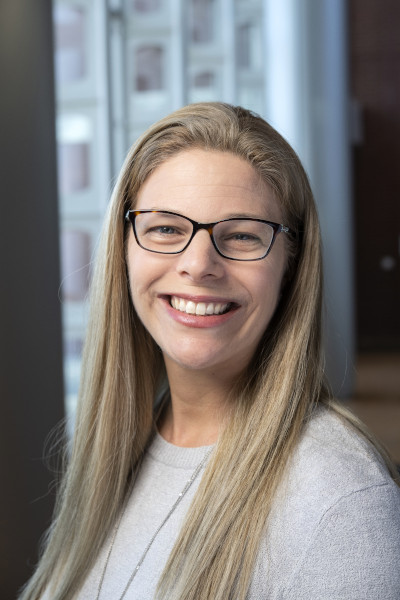College of Education and Human Development
NSF Grant Awarded to Inclusive Early Childhood Education Program Faculty in Support of Project to Advance Multi-User Virtual Reality Physics Classroom
September 19, 2024

Carley Fisher-Maltese
Carley Fisher-Maltese, associate professor in the Inclusive Early Childhood Education program within the School of Education at George Mason University, has been awarded a National Science Foundation grant in support of an interdisciplinary project titled “Advancing Multi-User Virtual Reality Classrooms to Support Collaborative Experiential Learning and Teaching of Introductory Physics” for which she is the Co-Principal Investigator. She is collaborating on this initiative with Lap-Fai (Craig) Yu, associate professor in the Computer Science Department in George Mason’s College of Engineering and Computing, who is the Principal Investigator.
The project focuses on a framework through which teachers can conduct physics classes in a virtual reality (VR) classroom, where students are given the opportunity to engage interactively and collaboratively in experiential learning experiences. The overall goal of this initiative is to help students develop a deeper conceptual understanding of introductory physics as they enhance their skills in conducting scientific experiments, work with their peers in direct scientific investigation, and build stronger confidence in the study of STEM subject matter. The framework upon which this project is based will allow for the instructional design of novel multi-user virtual reality physics class experiences, guided by the Next Generation Science Standards (NGSS).
Commenting on why she became involved in this project, Fisher-Maltese explained, “I am very interested in innovative technologies that can foster teacher and student STEM identities and enable students to pose and answer questions about real world problems.” This is her second NSF award. Fisher-Maltese received a Future of Work at the Human-Technology Frontier award in 2021 for her project titled “Transforming the Future of Work for Beekeepers Using Data Science” in which she explored the training of beekeepers and teachers in the use of data from sensor-enabled hives to assess hive health and associated environmental implications. She and Yu have previously partnered on various projects related to capturing VR footage of honeybee hives. Her current project working with Yu offers a novel, interdisciplinary research perspective by bringing together concepts and techniques from virtual reality, human-computer interaction, graphics, multimedia, networking, astronomy, physics, learning technologies, teaching technology integration in classrooms, instructional design, and science learning to advance the collaborative experiential learning and teaching of physics.
The main components of the project include:
- Investigation of the technologies conducive to developing a platform in support of a scalable, networked, multi-user virtual reality classroom for the experiential teaching and learning of physics where students and teachers can interact and collaborate in real time and in synchronized fashion regardless of where they are geographically located;
- Creation of interactive annotation, communication, and visualization tools for use in the collaborative experiential learning and teaching of physics in virtual reality;
- Development of lesson content tools, based on machine learning techniques, that will enable teachers to structure virtual reality physics classes that may be adapted and personalized to meet the learning needs of students; and,
- Assessment of the introductory physics education and content presented in the virtual reality classroom to gauge the success and effectiveness of teachers in promoting the learning, engagement, teamwork, and interest of students in the subject matter.
The project is informed by the constructivist and sociocultural principles of learning which hold that learning happens when students build their own knowledge through interactive experiences within the environment around them and by engaging with other individuals who are more knowledgeable.
Fisher-Maltese elaborated on how this project could help students and teachers alike by providing learning benefits specific to each group. She stated, “This project is important because it is a creative way to support teachers while understanding their current capacity to meet new curricular and instructional demands in science education. Many teachers feel unprepared to teach even introductory physics concepts, and there is a shortage of physics teachers. This project will benefit undergraduate and graduate non-physics majors in a teacher preparation program.” Fisher-Maltese is hopeful this project will encourage more pre-service teachers to consider specializing in physics or another STEM discipline when making career decisions.
In her other comments, Fisher-Maltese observed, “This project investigates a multi-user virtual reality classroom (MVRC) framework to push the boundaries of collaborative, experiential learning, and teaching of introductory physics. The idea is that it will lead to a deeper conceptual understanding of physics, better science teamwork skills, and stronger confidence and positive identity in STEM.”
In a discussion of the technical aspects of the project, the research team explains that current opportunities for interaction in most virtual reality classes are limited or non-existent because existing technology and application techniques have not yet evolved to the level where they can support multi-user, collaborative, experiential STEM learning on a large scale. The team hopes to overcome this limitation by developing system-level techniques for efficient remote rendering, viewport adaptive streaming, and peer-to-peer communications to enable the scalable delivery of networked, multi-user virtual reality physics classes. Embedded into these systems will be tools for students to use to engage with one another in conducting simulated experiments and for teachers to use in developing lessons that can be personalized according to a student’s level of competency and understanding of the physics concept being taught.
The research team believes that a virtual reality platform for the learning and teaching of physics can provide the following advantages:
- In virtual reality, it is possible to stimulate different senses (i.e., visual, auditory, tactical, kinesthetic), allowing for a more immersive experience thereby making learning more realistic;
- Virtual reality-based learning experiences permit a student to progressively learn from their own behaviors and decisions made in unlimited variations of representative conditions;
- STEM learning that takes place in a virtual reality environment avoids the risk and safety concerns of real-world experiments that involve objects such as weights, pulleys, and other equipment that can result in user injury if not operated properly;
- STEM classes conducted remotely in a scalable, shared multi-user virtual environment will be accessible to a broader range of students, including those from underserved communities, at a lower cost compared to classes held in a physical classroom; and,
- The actions and performance of the teacher and students can be recorded and displayed for review and analysis, making it easier to identify and implement any needed adjustments in the lesson content presented.
In conducting the assessment phase of this project, the research team will recruit students from the Inclusive Early Childhood Education and Learning Design and Technology programs within George Mason’s School of Education. These students will include pre-service teachers and instructional designers who will evaluate the MVRC framework for its potential user experience. Fisher-Maltese commented on the benefit that these students will receive from participating in this stage of the project. “The hope is that students from these programs will benefit from not only improving their conceptual grasp of physics, but also by developing practical skills in experiments and teamwork. By fostering a positive identity in STEM, participation in the project could boost students’ confidence in STEM and spark greater interest in scientific exploration,” she stated. Fisher-Maltese noted that adjustments to the framework will be made in accordance with the feedback received during the project’s assessment phase.
Please join us in congratulating Carley Fisher-Maltese on receiving this National Science Foundation grant in support of her work on this unique interdisciplinary project that will lead to the development of a scalable, multi-user virtual reality framework for teaching introductory physics. Her role in this initiative exemplifies the innovative and breakthrough research, often interdisciplinary in nature, that is conducted every day by faculty in the College of Education and Human Development.
